UML第一章UML与面向对象讲义-PPT-教程
1UML概述
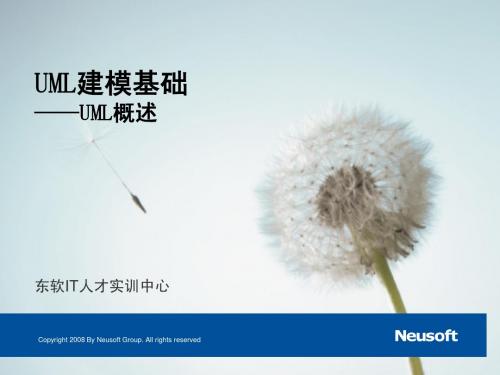
3 Sept. 2008 Confidential
UML概述 概述( 1.2 UML概述(续)
什么是模型? – 模型就是真实世界的简化 – 为我们提供一个系统的原型 为什么要建模? – 为了更好的理解我们将要或正在开发的系统 – 因为我们通常无法理解一个复杂系统的全部 – 模型能为我们做什么? 帮助我们对系统进行可视化 允许我们详细说明系统的结构或行为 给出一个指导我们构造系统的模板 对我们做出的决策进行文档化
3 Sept. 2008 Confidential
UML概述 概述( 1.2 UML概述(续)
什么是可视化建模?
"建模获取系统的关键部分"
UML
业务流程
可视化建模就是用标准的 图形表示法来建模
3 Sept. 2008 Confidential
计算机系统
1.3 可视化建模的作用
可视化建模获取业务流程 – 用例(use case)分析是一种从用户的角度获取业务流 程的技术 – 使用相同的语言,不至于产生歧义 – 用例分析能让分析师在构建系统之前理解要构建什么
分析师 设计师 structure
最终用户 Functionality
Use-case View Process View
系统集成员 Performance Scalability Throughput
Deployment View
系统工程 System topology Delivery installation Communication
UML的概念模型 的概念模型( 1.4 UML的概念模型(续)
UML元素 – 构造块 – 事物(续) – 行为事物:是UML模型的动态部分,是模型中的动词 交互(interaction):可描述一个对象群体的行为或 单个操作的行为 状态机(state machine):可描述单个类或一组类之 间协作的行为
第三部分UML基础(第一章UML概述)
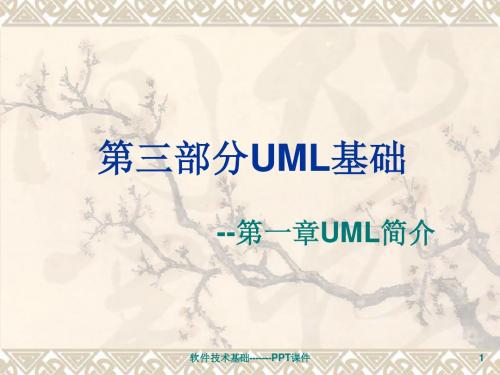
1、标准的表示方法
人们用各种方法来使用UML,而无论方
法如何变化,它们的基础是UML的图。 这就是UML的最终用途——为不同领域 的人们提供统一的交流标准。 软件开发的难点在于:一个项目的参与 包括领域专家、软件设计开发人员、客 户,以及用户他们之间交流的难题,成 为软件开发的最大难题。
最突出的两条,
一是:注重系统架构的开发 一是:注重过程的迭代和递增性
尽管UML
本身对过程没有任何定义,但 UML 对任何使用它的方法或过程提出的 要求,是支持用例驱动use-case driven 、以架构为中心architecturecentric 以及递增incremental 和迭代 iterative 地开发。
26
四、UML 的应用领域
UML
被用来为系统建模,它可应用的范 围非常广泛:
可以描述许多类型的系统
它也可以用在系统开发的不同阶段,从需
求规格说明到对已完成系统的测试。
软件技术基础-------PPT课件
27
1、在不同类型系统中的应用
的目标是:用面向对象的方式描述 任何类型的系统。 其中最直接的是,用UML 为软件系统创 建模型。但UML 也可用来描述其它非计 算机软件的系统,或者是商业机构或过 程。
UML是一种建模语言,是一种标准的表
示,而不是一种方法或方法学。
方法是一种把人的思考和行动结构化的明
确方式。方法需要定义软件开发的步骤, 告诉人们做什么,如何做,什么时候做以 及为什么要这么做
UML只定义了一些图以及它们的意义。
它的思想是与方法无关。
软件技术基础-------PPT课件 20
软件技术基础-------PPT课件 4
UML第1章 面向对象方法概论
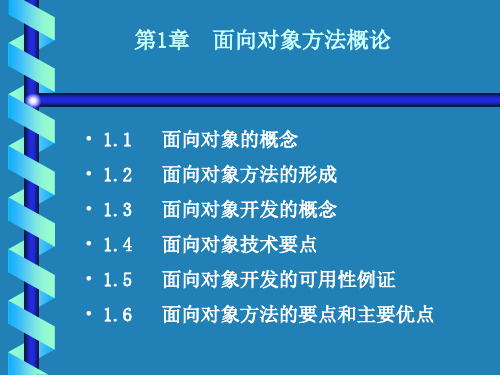
1.3
面向对象开发的概念
面向对象开发是现实世界中以抽象为基础的 软件思维的一种崭新方式。面向对象开发的本质 是应用领域概念的鉴别和组织,而不是它们在一 种程序设计语言中的最终表示。
1.3.1
面向对象方法学
• • • •
分析 系统设计 对象设计 实现
1.3.2 • 对象模型 • 动态模型 • 功能模型
• 所谓“描述”是指用一种语言把人们对问题域 中事物的认识、对问题及其解决方法的认识描 述出来。最终的描述必须使用一种能够被机器 读得懂的语言,即编程语言。
1.2.2 • • • • • • 标识 分类 多态性 继承 封装 抽象
对象的特性
1.2.3
软件工程学的作用
• 软件工程学从认识事物方面看,它在分析阶段 提供了一些对问题域的分析认识方法。从描述 事物方面看,它在分析和设计阶段提供了一些 从问题域逐步过渡到编程语言的描述手段 。 • 传统的软件工程方法(图1-1)与面向对象的 软件工程方法(图1-2)比较
问题域 需求分析 总体设计和详细设计 编程和测试 软件维护
图1-1
问题域 自然语言 面向对象的编程语言 OOA OOD OOP OOT 计算机
图1-2
• 传统的软件工程方法: 1)需求分析 2)总体设计和详细设计 3)编程和测试 4)软件维护
• 面向对象的软件工程方法 1)面向对象的分析 2)面向对象设计 3)面向对象的编程 4)面向对象的测试 5)面向对象的软件维护
• 面向对象方法的主要优点是 : (1)与人类习惯的思维方法一致 (2)稳定性好 (3)可重用性好
(4)可维护性好 (5)面向对象的软件稳定性比较好 (6)面向对象的软件容易修改 (7)面向对象的软件容易理解 (8)易于测试和调试
面向对象方法UML(1)
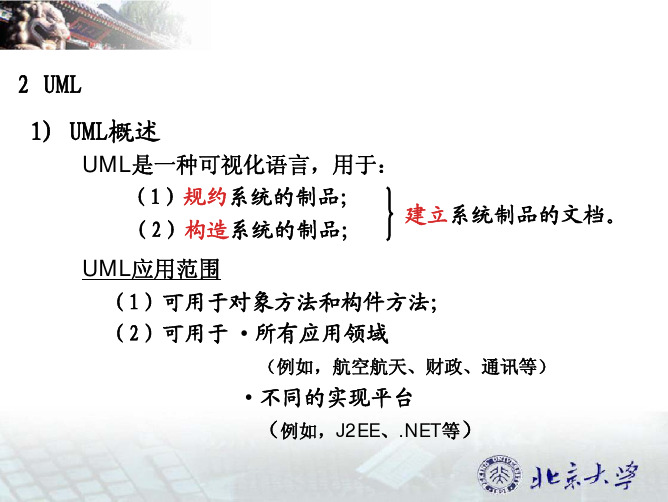
类(Class):是一组具有相同属性、操作、关系和语 义的对象的描述。 对象(object):对象是类的一个实例。
类表示为具有三个栏目的矩形,如下所示:
依据类出现的场景, 可以给出如下简化的表示:
类所在的包名
简单名 限定名
类可以是抽象类,即没有实例的类,此时类名采用斜体字. 例如: Window Window size:Area visibility:Boolean display( ) hide( )
属性的作用范围:
(1)实例范围的属性:一个类的所有对象具有相同的属性即属性的个数、名 称、数据类型相同,但属性值可不同,并随程序的执行而变化.实例范围的 属性是默认的,不需要附加的符号. (2)类范围的属性:描述类的所有对象共同特征的一个数据项,对于任何对 象实例,它的属性值都是相同的,通常对属性加下划线来表示该属性为实例 范围的属性. 注:如C++中冠以static的成员变量和smalltalk中的class attribute都是 类属性。
19
返回类型 返回类型是对操作的实现类型或操作的返回值类型的 规约,它与具体的实现语言有关。如果操作没有返回值(例 如C++ 中的void),就省略冒号和返回类型。当需要表示多 个返回值时,可以使用表达式列表。 根据实际问题的需要,可以省略全部的参数表和返回类 型,但不能只省略其中的一部分。
20
性质串 给出应用于该操作的性质值。该项是是可选的,但若省略操 作的性质串,就必须省略括号。UML提供了以下标准的性质值:
•leaf:指明该操作是“叶子”操作; •abstract:指明该操作是抽象操作; •query:指明该操作的运行不会改变系统状态,即是完全没有副作用的纯函数。 •sequential:指明在该类对象中,一次仅有一个控制流. •guarded:指明执行该操作的条件,实现操作调用的顺序化,即一次只能调用对 象的一个操作,以保证在出现多控制流的情况下,对象具有的语义和完整性. •Concurrent:指明来自并发控制流的多个调用可以同时作用于一个对象的任何一 个并发操作,而所有操作均能以正确的语义并发进行.并发操作必须设计成:在 对一个对象同时进行顺序的或监护的操作情况下仍能正确地执行. •static 指明该操作没有关于目标对象的隐式参数,其行为如同传统的全局过程 . 其中,包含一些用于表达操作的并发语义,例如guarded、Concurrent等, 这些特性是一些仅与主动对象、进程或线程有关的特性。如果没有对并发语义进 行说明,那么就假设操作是顺序执行的。
UML概述ppt课件精选全文

注释体 用于对UML实体进行文字描述
注释连接
注释连接将注释体与要描述的实体相连。说 明该注释体是对该实体所进行2-
协作图(通讯图)
协作图表示一组对象间关系以及交互活动
协作图可以认为是对象图的扩展,它增加了一些符号用于表 示对象间的交互。协作图和顺序图具有同构性。
指向源同步 消息
表示对象间从目的对象向源对象发送同步消息
指向目的的 同步消息
表示对象间从源对象向目的对象发送同步消息
注释体
注释连接
-35-
示例:协作图
-36-
活动图
活动图:通过动作来组织,主要用于描述某一方法、机制或 用例的内部行为
主要使用场合:业务建模、用例分析
-37-
活动图元语-1
活动 组合活动
1997.1公布 UML 1.0 合作伙伴
业
公
意见
众 1996.6和1996.10 UML 0.9&0.91
化
反
馈 OOPSLA95 Unified Method 0.8
标
准
Booch93 OMT-2
化
Booch91 OOSE
OMT-1 其他方法 统
一
UML基本图
静态模型 (系类统图结 构) class diagrams
转移
用于说明两个对象间存在某种关系,如满足某 个条件并当某一事件发生时,对象将从一个状 态变迁到另一个状态并同时执行一些活动
注释体
注释连接
示例:状态图
顺序图
顺序图:主要用于显示对象间的交互活动,但没有明确的交 互环境和对象状态
主要使用场合:系统分析(用例分析)、设计
NIIT UML中文PPT1
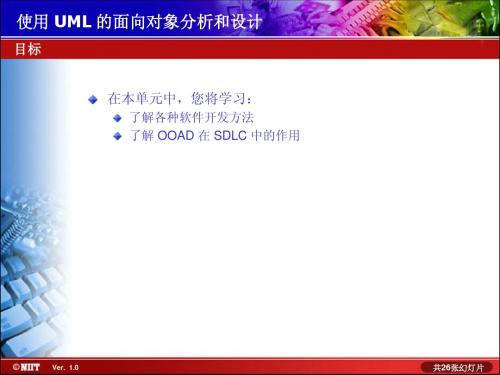
共26张幻灯片 张幻灯片
使用 UML 的面向对象分析和设计
瀑布方法 (续.) 续
下图显示瀑布方法的各个阶段:
Ver. 1.0
共26张幻灯片 张幻灯片
使用 UML 的面向对象分析和设计
原型方法
又称为演化方法. 是一个系统的实现样本,该系统将展示目标系统的主要功能. 在需求收集和分析阶段中使用该方法以获取建议系统的确切 需求.
Ver. 1.0
共26张幻灯片 张幻灯片
使用 UML 的面向对象分析和设计
增量方法
在增量方法中,软件需求可分解为不同的功能单元. 每个功能单元都在一次增量中实现. 当在开发过程中实现了 所有功能单元之后,就将获得最终产品. 增量方法中每个增量包含三个阶段:
设计 实现 分析
Ver. 1.0
共26张幻灯片 张幻灯片
Ver. 1.0
共26张幻灯片 张幻灯片
使用 UML 的面向对象分析和设计
SDLC 阶段概览
SDLC 可分为六个阶段:
可行性分析 需求分析和规范说明 设计 编码 测试 维护
Ver. 1.0
共26张幻灯片 张幻灯片
使用 UML 的面向对象分析和设计
软件开发方法
不同类型的项目有不同的需求. 需要剪裁 SDLC 的各个阶段以满足项目的特定要求. 剪裁 SDLC 的各个阶段导致软件的开发方法各不相同:
小结(续 小结 续)
面向对象(OO)方法支持重用,数据封装,以及继承,抽象和 多态性等概念. OOAD 指根据对象,类,封装,继承,多态,抽象和动态邦定 来分析需求和设计软件系统.
Ver. 1.0
共26张幻灯片 张幻灯片
�
Ver. 1.0
共26张幻灯片 张幻灯片
UML-面向对象的分析和设计

面向对象分析与设计
15/180
注意,执行者与用户是不同的两个概念, 注意,执行者与用户是不同的两个概念,一个用 户可以扮演几个角色(执行者), ),一个执行者可以是 户可以扮演几个角色(执行者),一个执行者可以是 用户,也可以是其他系统(应用程序或设备)。 )。得到 用户,也可以是其他系统(应用程序或设备)。得到 的用例必须进行复审,以使需求完整。 的用例必须进行复审,以使需求完整。
构成类图的元素所表达的模型信息, 构成类图的元素所表达的模型信息, 对象层 分为三个层次: 分为三个层次: 三个层次 对象层—给出系统中所有反映问题域 对象层 给出系统中所有反映问题域 特征层 系统责任的对象。 和系统责任的对象。 特征层—给出类 对象)的内部特征, 给出类( 特征层 给出类(对象)的内部特征, 关系层 即类的属性和操作。 即类的属性和操作。 关系层—给出各类 对象) 给出各类( 关系层 给出各类(对象)之间的关 图 OOA基本模型 基本模型 包括继承、组装、一般—特殊 系,包括继承、组装、一般 特殊 、整 体—部分、属性的静态依赖关系,操作的 部分、属性的静态依赖关系, 部分 动态依赖关系。 动态依赖关系。
目录
首页
末页
面向对象分析与设计
6/180
抽象类与子类示例
Shape { abstract } draw ( ) { abstract }
Abstract class Abstract operation
Circle draw ( )
Rectangle draw ( )
目录
首页
末页
面向对象分析与设计
目录 首页 末页
面向对象分析与设计
18/180
构造对象—关系模型 4. 构造对象 关系模型
uml 基础教程 第一章--uml与面向对象
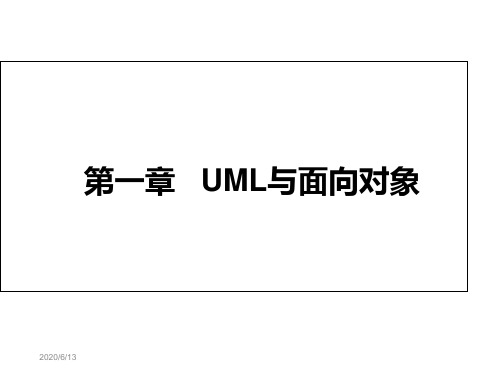
2020/6/13
基础内容:类和对象的关系 重点掌握:面向对象的四个特征 一般了解:面向对象项目的设计
2020/6/13
1.1 面向对象开发
1.1.1 理解面向对象
一、对象
• 面向对象认为客观世界是由各种各样的对象组成, 每个对象都有自己的数据和操作,对象和对象之间 是通过对象暴露在外的接口进行调用的,不同对象 之间的相互作用和联系构成了各种系统。
2020/6/13
•面向对象概念中,这种关系叫继承。每个Appliance 的子类都继承了Appliance的特征。同时,要重点注 意下,每个子类都增加了自己的属性和操作。 •因此,继承是一种连接类与类之间的层次模型,是 指特殊类的对象拥有其一般类的属性和行为。特殊 类中不必重新对已经在一般类中所定义的属性和行 为进行定义。特殊类自动地、隐含地拥有其一般类 的属性和行为。
0/6/13
• 在设计阶段,要考虑的是定义软件系统中技术细 节的类(如处理用户接口、数据库、通信和并行性 等问题的类),把分析阶段的结果扩展成技术解决 方案。
• 构造阶段,把设计阶段的类转换成某种面向对象 程序设计语言的的代码(工具可以完成)。
• 测试阶段,系统通常需要经过单元测试、集成测 试、系统测试和验收测试。不同的测试小组使用不 同的UML图作为测试依据:单元测试使用类图和类 规格说明;集成测试使用构件图和协作图;系统测 试使用用例图来验证系统的行为;验收测试由用户 进行,以验证系统测试的结果是否满足在分析阶段 确定的需求。
2020/6/13
1.2 UML简介
1.2.1 对系统建模的必要性
UML具体有哪些作用:
• (1)对于软件系统用户,软件的开发模型向他们 描述了软件开发者对于软件系统需求的理解。
第1章 UML与面向对象
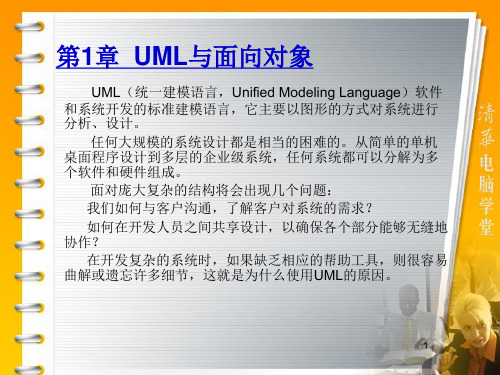
面向对象的软件开发
• 面向对象的分析(OOA):从问题域中 获取需要的类和对象,以及它们之间的 关系,主要表达“做什么”。
• 面向对象的设计(OOD):建立可靠的 、可实现的系统模型,完善OOA的成果 ,表达“怎么做”。
• 面向对象的编程(OOP):利用某种支 持面向对象的语言实现系统中的类,对 象,并使得系统能够正常运行。
• 概括地说,面向对象方法的基本思想包括两个主 要方面。一方面是从现实世界中客观存在的事务出 发来构造软件系统,并在系统的构造中尽可能地运 用人类的自然思维方式。开发一个软件是为了解决 某些问题,这些问题所涉及的业务范围称为该软件 的问题域。面向对象方法强调直接以问题域中的事 物为中心来思考问题、认识问题,并根据这些事物 的本质特征把它们抽象为系统中的对象,以对象作 为系统的基本构成单位。这可以使系统直接地映射 问题域,保持问题域中的事物及其相互关系的本质 。
1
本章学习要点:
• 理解面向对象概念 • 了解OO开发 • 熟悉OO开发的优点 • 掌握OO开发三层设计 • 了解模型的作用 • 了解面向对象的主要概念 • 了解UML的发展 • 掌握UML四层结构 • 了解统一的含义 • 理解UML视图和图的关系 • 掌握UML模型元素内容 • 理解UML通用机制 • 了解UML建模在软件开发中应用
8
6.多态性
同一个方法在不同的场合表现出不同的功能。
private void button1_Click(object sender, EventArgs e)
{
label1.Text = add(38,48).ToString();
}
private int add(int x, int y)
{
面向对象与UML1

统一建模语言
UML概述
UML是一种语言 UML是一种可视化语言
UML是一种可用于详细描述的语言
UML是一种构造语言 UML是一种文档化语言
事物
结构事物 行为事物 分组事物 注释事物
依赖 关联 泛化 实现 聚集
关系
图 类图 对象图 包图 组合结构图 构件图 部署图 制品图
公共机制
规格说明 修饰 公共分类 扩展机制
用例图(用例) 顺序图/序列图 通信图/协作图 定时图 状态转换图 活动图 交互概览图
18
抽象
数据抽象
制造商 模块数 类型 转动方向
插入 灯 类型 数量 重量
打开机制
实现为一个数据结构
19
抽象 过程抽象
进门细节 算法
用与进门有关的对象的“知识” 来实现 20
封装
封装 属性和操作统一为一体,隐藏内部构造。 提高对象的独立性 公开可以让外部调用的操作(接口) 接口相同的话对象可自由组合
接口 对象A
对象B 交换可能 对象C
7
面向对象的优点(3)
对应变化很强。即易扩展,维护性强
由于有封装性,多态性等,
即便数据的型或数有变化,只需变更自己的操作(方法)的算法。 操作的用法(接口)没有变化的话,对其他对象没有影响。 容易通过差分编程进行扩张。
没有影响
对象
对象
操作 即便属性或操作逻辑发生变更, 可在对象自身内吸收。 属性
UML第1章面向对象概述PPT课件

▪ 在面向对象的建模方法中,主要的 模块是对象或者类。
UML建模语言
面向对象的建模语言—统一建模语言UML
▪ Booch 1993(Grady Booch) ▪ OOSE(Jim Rumbaugh) ▪ OMT-2(Ivar Jacobson)
1. 面向对象分析过程模型
UML建模语言
面向对象分析的基本原则
① 抽象原则 ② 分类原则 ③ 聚合原则 ④ 关联原则 ⑤ 消息通信原则
Hale Waihona Puke UML建模语言1.3 面向对象方法论
1.3.1 面向对象分析(P11图1-4) 1. 获取问题域陈述 2. 建立系统的对象模型 3. 建立对象的动态模型 4. 建立系统的功能模型
▪ 对象是问题域或实现域中某些事物的一个抽象。 ▪ 对象是一个封装数据属性和操作行为的实体。 ▪ 系统中的对象在软件生命周期的各个阶段可能有
不同的表示形式。
UML建模语言
1. 一个对象的实例图解
UML建模语言
1. 2. 封装
▪ 封装是面向对象方法的一个重要原则。 ▪ 封装有两个含义: ① 结合性 ② 信息隐蔽性
6. 多态性
▪ 定义:同一操作作用于不同的对象,可以 有不同的解释,产生不同的执行结果。
▪ 多态性分为两种: ① 编译时的多态性。 ② 运行时的多态性。
UML建模语言
6. 多态性
▪ 多态性的实现方式: ① 通过接口实现多态性 ② 通过继承实现多态性 ③ 通过抽象类实现的多态性
UML建模语言
7. 结构与连接
面向对象:以对象为基础,以事件或消息来驱 动对象执行处理,是自下而上的程序设计方法, 其特点是,从问题的一部分着手,在设计中以数 据为中心,类为工具.
UML面向对象的分析1

UML面向对象的分析第一章面向对象的软件工程简介一、传统软件工程方法存在的问题软件工程提出至今,并没有从根本上解决软件开发问题,软件危机现象依然存在。
就其原因:主要是随着软件应用范围的扩大,软件问题越来越复杂,但也有传统软件工程本身存在的问题,表现在:1、预定义需求的假设是不现实的:需求是模糊的、变化的;需求的沟通是困难的。
2、结构化分析和设计方法存在的问题:需求以功能为基础,分析和设计以过程为基础。
3、思维方式(认识、分析问题的思想方法)与人们平常的习惯不一致。
为了解决这一问题,软件工程有了新的发展:快速原型法和面向对象法。
下面只介绍面向对象的软件工程方法。
二、面向对象的软件工程方法简介 1、基本思想:使软件开发的过程、方法和思想与现实问题的结构以及人类认识和解决问题的方法相一致。
要点:认为客观世界是由各种对象组成的所有对象都划分成各种对1/ 4象类自然界中的所有类组成类的层次结构对象之间通过消息相互联系面向对象 = 对象 + 类 + 继承 + 通讯软件开发的优点:与人类习惯的思维方式一致稳定性好:传统方法基于功能的分析和分解,功能的变化常常会引起软件系统结构的变化。
而在 OO 方法中,功能的变化往往采用从已有类派生出新的子类的方法以实现功能的扩充和修改。
可重用性好:对象和类都是可重用的软件预制件,通过参数化和实例化增加重用性。
可维护性好:独立性好,稳定、易于修改、修改造成的影响小、易于理解。
2、基本概念:对象:是现实中任何可以明确界定和区别的事物或其抽象的实体和概念。
Object = lt; ID, MS, DS, MI gt; 其中:ID:标识; MS:操作集合; DS:数据结构; MI:消息集合类:一组对象共同属性(数据和操作)的抽象。
实例:一个具体的个体。
消息:对象操作的具体调用说明。
方法:操作的具体算法。
属性:描述对象特性的数据。
继承:子类自动共享父类中定义的数据和方法的机制。
对象之间的关系:ISA(抽象), PART OF(聚合),关联(除此之外)。
- 1、下载文档前请自行甄别文档内容的完整性,平台不提供额外的编辑、内容补充、找答案等附加服务。
- 2、"仅部分预览"的文档,不可在线预览部分如存在完整性等问题,可反馈申请退款(可完整预览的文档不适用该条件!)。
- 3、如文档侵犯您的权益,请联系客服反馈,我们会尽快为您处理(人工客服工作时间:9:00-18:30)。
Ver. 1.0
Slide 3 of 26
Object-Oriented Analysis and Design Using UML
Software Development Approaches
Different types of projects have different requirements. It is required to tailor the SDLC phases to meet the specific needs of the project. The tailoring the SDLC phases, gives rise to various software development approaches:
Ver. 1.0
Slide 1 of 26
Object-Oriented Analysis and Design Using UML
Understanding Software Development Life Cycle (SDLC)
SDLC is a disciplined and systematic approach that divides the software development process into various phases, such as requirements, design, and coding. The phase-wise software development process helps you track schedule, cost, and quality of the software projects.
Conception Initiation Analysis Design Construction Integration and testing Implementation and maintenance
Ver. 1.0
Slide 5 of 26
Object-Oriented Analysis and Design Using UML
Limitations of prototyping approach:
Gives clients the false impression that a few minor changes to the prototype will give them the required system. May compromise on the overall quality of the software in the rush to develop the prototype.
Win-Win Spiral Approach
Is an extension of the spiral approach. The phases in this approach are same as the phases in the spiral approach. In this approach, the development team and the customer hold discussions and negotiate on the requirements that need to be included in the current iteration. The approach is called win-win because it is a winning situation for the development team and also for the customer. The win-win spiral approach is generally used when you have time-bound releases.
Waterfall approach Prototyping approach Spiral approach Win-win spiral approach Incremental approach
Ver. 1.0
Slide 4 of 26
Object-Oriented Analysis and Design Using UML
1. Incremental approach 2. Spiral approach 3. Evolutionary approach
Answer:
Spiral approach
Ver. 1.0
Slide 14 of 26
Object-Oriented Analysis and Design Using UML
Design Implementation Analysis
Ver. 1.0
Slide 12 of 26
Object-Oriented Analysis and Design Using UML
IncremBiblioteka ntal Approach (Contd.)
The following figure shows the Incremental approach with various phases:
Object-oriented approach:
Portrays things as they exist in the real world. Introduces the concept of inheritance which allows reuse of existing code components. Supports inheritance, reusability and encapsulation of data, abstraction, and polymorphism.
Customer communication Planning Risk analysis Engineering Construction and release Customer evaluation
Ver. 1.0
Slide 9 of 26
Object-Oriented Analysis and Design Using UML
Ver. 1.0
Slide 7 of 26
Object-Oriented Analysis and Design Using UML
Prototyping Approach (Contd.)
Various types of prototypes:
Throwaway prototypes Evolutionary prototypes
Waterfall Approach
Describes the software development process in a linear sequential flow. Is the earliest approach used for software development. Defines the software development process in seven phases:
Understanding Object-Oriented Concepts
In the design phase, there are two approaches to software development:
Function-oriented approach:
Is module-centric and concentrates on functions of the software.
Spiral Approach (Contd.)
The following figure shows the various phases of the spiral approach:
Ver. 1.0
Slide 10 of 26
Object-Oriented Analysis and Design Using UML
Object-Oriented Analysis and Design Using UML
Objectives
In this session, you will learn to:
Identify the various software development approaches Identify the role of OOAD in SDLC
Ver. 1.0
Slide 11 of 26
Object-Oriented Analysis and Design Using UML
Incremental Approach
In an incremental approach, software requirements are broken down into various functional units. Each functional unit is implemented in an increment and the final product is achieved after all the functional units are implemented in the development process. Each increment in the incremental approach includes three phases:
Waterfall Approach (Contd.)
The following figure shows various phases of the waterfall approach:
Ver. 1.0
Slide 6 of 26
Object-Oriented Analysis and Design Using UML
Ver. 1.0
Slide 13 of 26
Object-Oriented Analysis and Design Using UML
